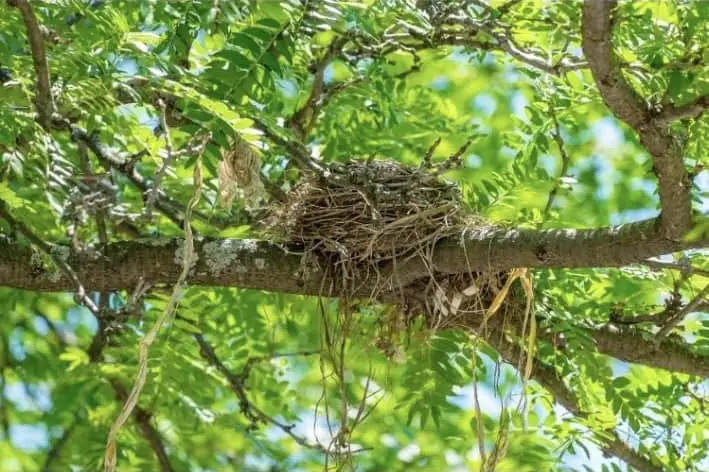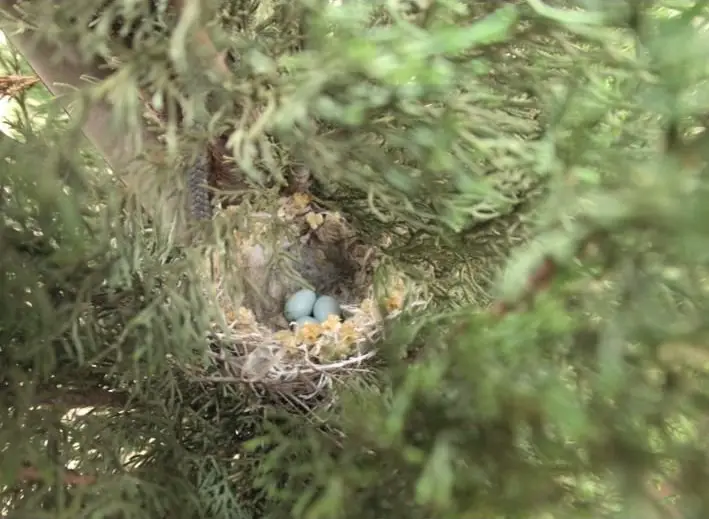There’s something delightful about watching robins hop around in your backyard. These cheerful birds are known for their bright red breasts and happy chirping. But during their breeding season, do they reuse the same nests over and over again?
This article will explore the answer to that question and offer some fun facts about robin nests. Keep reading to learn more!
Robins can be found throughout the UK in areas with trees and bushes. They are birds that can nest pretty much anywhere and they mainly consider a nesting site that is concealed and hidden from predators. Robins are also cavity nesters, meaning that they use existing holes or crevices to make their nests. This can include tree hollows, birdhouses, and even abandoned mammal burrows.
Some robins also build their nests in locations such as hanging baskets, farm machinery, sheds, and even boats. However, most nests are built in trees, nooks and crannies, logs, hedge banks, and other sheltered places.
There are usually around 250 pairs of robins per square mile in the UK. This means that it is likely that there will be at least one robin in your garden.
In fact, one way to help attract robins to your garden is by putting up a nest box. This will provide the birds with a place to build their nests and lay their eggs. Robins like to use open-fronted nest boxes placed in low down, sheltered positions. You can buy a nest box or make your own from an old wooden box or barrel. The lack of nesting sites in the UK makes it essential for people to create safe places for robins in the gardens.
The nesting season for robins begins in March and goes until early July. The robins will start gathering nesting materials and building their nest for about four days. The nests are made of twigs, grasses, leaves, and other natural materials that the robin can find. Robins often line their nests with fine grass, hair, or feathers to make them softer and warmer.

Robins typically have four to five broods per year, and the female robin lays four to six eggs for each brood and sits on them for approximately twelve days until they hatch. After the eggs have hatched, the chicks stay in the nest for another two to three weeks before they fledge. Male robins help out with the nesting process by bringing food to the female and the chicks. They will also help protect the nest from predators and other dangers.
Robins are very territorial and will often attack other birds, including other robins, that come too close to their nests. This is why you are more likely to see a robin on its own rather than in a group.
Although robins don’t reuse the same nest, they often build their nests in the same spot again if they have a successful breeding season. This behaviour allows for a greater chance of successful reproduction as robins have an instinctual understanding of what makes a good nesting site. In addition, robins return to the same location to build a new nest as it is proven to be in better condition, leading to more eggs surviving until hatching.
Baby robins are born without feathers or sight. After about five days, they will open their eyes and grow feathers. Robins are then ready to leave the nest after fourteen days.
Adult robins take turns feeding the baby birds in the nest. They might make up to a hundred feeding trips in one day. The chicks are fed on regurgitated food that the parents have partly digested, which is high in protein and helps the chicks to grow quickly.
The baby robins will then start eating insects and worms. The parents will continue to bring food to the nest until the young birds can fly and fend for themselves, usually for two weeks. The adult robins will look after the chicks for three more weeks before they are entirely independent.
Robins are one of the earliest spring migrants, so if you’re looking for something to watch in your yard as the weather starts to warm up, keep an eye out for them. Here are some tips on how to help robins nest in your garden:
- If you have a nest box available, place it in a low down, sheltered position. Robins prefer openings that are wide enough for them to enter
- If you don’t have a nest box available, try to provide a natural nesting site for the birds. This could be an area with low growing shrubs or trees
- Keep your garden free from any harmful chemicals or pesticides. These can be toxic to birds and their offspring
- Keep an eye on the nest to ensure that no predators come near it. If you have pets, make sure they are kept away from the nest box or nesting area
- If you have a bird feeder, try to put it near the nest box so the robins can easily access it. Robins love to eat insects, so make sure you provide a variety of food items that will appeal to them
By following these tips, you can help support robin nesting in your garden and enjoy watching these beautiful birds raise their young.
Robins are one of the most prevalent backyard birds in the UK. They are easily recognisable by their bright red breasts and cheerful songs. Robins are mostly found in woodlands, but they will also nest in gardens if the conditions are suitable.
During the breeding season, robins typically return to the same area to build their nests and raise their young. If you want to entice robins to your garden, make sure you provide a nesting site and plenty of food. These birds are a delight to watch, and it is fascinating to see them raise their young.

